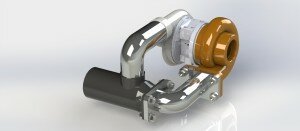The MovEnergy Engine work with an excess air-to-fuel ratio of 60:1
Internal combustion engine-powered generator sets fueled by natural gas are commanding more attention these days as interest grows in on-site power production equipment that is both efficient and environmentally friendly.
In response to this interest, manufacturers have introduced natural gas engine-powered generator sets that feature “lean-burn” technology. The combustion is considered “lean” when excess air is introduced into the engine along with the fuel.
Lean-burn means pretty much what it says. It is a lean amount of fuel supplied to and burned in an engine’s combustion chamber. Normal air-to-fuel ratio is on the order of 15:1 (15 parts air to 1 part fuel). True lean-burn can go as high as 23:1.
Lean-burn engines (both gasoline and diesel) enjoy higher fuel economy and cleaner emissions than conventionally tuned engines. By nature they use less fuel and emit fewer unburned hydrocarbons and greenhouse gases while producing equivalent power of a like-sized “normal” combustion engine. They achieve lean-burn status by employing higher combustion chamber compression ratios (higher cylinder pressure), significant air intake swirl and precise lean-metered direct fuel injection.
Optimizing a engine efficiency is important to minimize fuel consumption and unwanted excess to the environment
- when fuel and oxygen in the air are in perfectly balance – the combustion is said to be stoichiometric
The combustion efficiency will increase with increased excess air, until the heat loss in the excess air is larger than than the heat provided by more efficient combustion.

Typical excess air to achieve highest efficiency for different fuels are
- 5 – 10% for natural gas
- 5 – 20% for fuel oil
- 15 – 60% for coal
Carbon dioxide – CO2 – is a product of the combustion and the content in the flue gas is an important indication of the combustion efficiency.

An optimal content of carbon dioxide – CO2 – after combustion is approximately 10% for natural gas and approximately 13% for lighter oils.
Normal combustion efficiencies for natural gas at different amounts of excess air and flue gas temperatures are indicated below:
| Combustion Efficiency (%) | ||||||
| Excess % | Net Stack Temperature1) (oF) | |||||
| Air | Oxygen | 200 | 300 | 400 | 500 | 600 |
| 9.5 | 2.0 | 85.4 | 83.1 | 80.8 | 78.4 | 76.0 |
| 15 | 3.0 | 85.2 | 82.8 | 80.4 | 77.9 | 75.4 |
| 28.1 | 5.0 | 84.7 | 82.1 | 79.5 | 76.7 | 74.0 |
| 44.9 | 7.0 | 84.1 | 81.2 | 78.2 | 75.2 | 72.1 |
| 81.6 | 10.0 | 82.8 | 79.3 | 75.6 | 71.9 | 68.2 |
1) The “net stack temperature” is the difference between the flue gas inside the chimney and the room temperature outside the burner.
Flue Gas Loss Combustion Oil
The relationship between temperature difference flue gas and supply air, CO2 concentration in the flue gas, and the efficiency loss in the flue gas combustion oil, is expressed in the diagram below.


